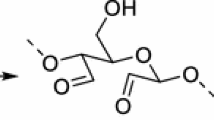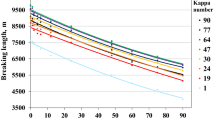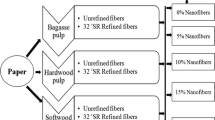Abstract
The market for cellulosic fiber based food packaging applications is growing together with the importance of improving the thermal durability of these fibers. To shed light on this, we investigated the role of residual lignin in pulp on the thermal stability of refined pulp sheets. The unbleached, oxygen delignified, and fully bleached pulp sheets were studied after four separate refining degrees. Comparison by Gurley air resistance, Bendtsen porosity, and the oxygen transmission rate tests showed that lignin containing sheets had better air and oxygen barrier properties than fully bleached sheets. Sheet density and light scattering coefficient measurements further confirmed that the lignin containing pulps underwent more intense fibrillation upon refining that changed the barrier properties of the sheets. Thermal treatments (at 225 °C, 20 and 60 min, in water vapor atmospheres of 1 and 75 v/v %) were applied to determine the thermal durability of the sheets. The results revealed that the residual lignin in pulps improved the thermal stability of the pulp sheets in the hot humid conditions. This effect was systematically studied by tensile strength, brightness, and light absorption coefficient measurements. The intrinsic viscosity results support the findings and suggest that lignin is able to hinder the thermal degradation of pulp polysaccharides. In spite of the fact that lignin is known to enhance the thermal yellowing of paper, no significant discoloration of the pulp sheets containing residual lignin was observed in the hot humid conditions (75 v/v %). Our results support the idea of lignin strengthening the thermal durability of paper.







Similar content being viewed by others
References
Andersson C (2008) New ways to enhance the functionality of paperboard by surface treatment—a review. Pack Technol Sci 21:339–373. doi:10.1002/pts.823
Arshanitsa A, Ponomarenko J, Dizhbite T, Andersone A, Gosselink RJA, Van Der Putten J, Lauberts M, Telysheva G (2013) Fractionation of technical lignins as a tool for improvement of their antioxidant properties. J Anal Appl Pyrolysis 103:78–85. doi:10.1016/j.jaap.2012.12.023
Baptista C, Robert D, Duarte AP (2008) Relationship between lignin structure and delignification degree in Pinus pinaster kraft pulps. Bioresour Technol 99:2349–2356. doi:10.1016/j.biortech.2007.05.012
Beyer M, Lind A, Koch H, Fischer K (1999) Heat-induced yellowing of TCF-bleached sulphite pulps—mechanistic aspects and factors that influence that process. J Pulp Pap Sci 25:47–51
Beyer M, Koch H, Fischer K (2006) Role of hemicelluloses in the formation of chromophores during heat treatment of bleached chemical pulps. Macromol Sympos 232:98–106. doi:10.1002/masy.200551412
Boeva R, Radeva G, Hinkov P, Hinkov E (2012) Thermal ageing of different kinds of fiber materials: a kinetic study. J Univ Chem Technol Met 47:37–42
Borrega M, Tolonen LK, Bardot F, Testova L, Sixta H (2013) Potential of hot water extraction of birch wood to produce high-purity dissolving pulp after alkaline pulping. Bioresour Technol 135:665–671. doi:10.1016/j.biortech.2012.11.107
Brebu M, Vasile C (2010) Thermal degradation of lignin—a review. Cell Chem Technol 44:353–363
Castle L, Jickells SM, Gilbert J, Harrison N (1990) Migration testing of plastics and microwave-active materials for high-temperature food-use applications. Food Addit Contam 7:779–797. doi:10.1080/02652039009373940
Chirat C, De La Chapelle V (1999) Heat- and light-induced brightness reversion of bleached chemical pulps. J Pulp Pap Sci 25:201–205
Cui C, Sadeghifar H, Sen S, Argyropoulos DS (2013) Toward thermoplastic lignin polymers; part II: thermal and polymer characteristics of kraft lignin and derivatives. BioResources 8:864–886
Dizhbite T, Telysheva G, Jurkjane V, Viesturs U (2004) Characterization of the radical scavenging activity of lignins—natural antioxidants. Bioresour Technol 95:309–317. doi:10.1016/j.biortech.2004.02.024
Fardim P, Durán N (2003) Modification of fibre surfaces during pulping and refining as analysed by SEM, XPS and ToF-SIMS. Colloids Surf A Physicochem Eng Asp 223:263–276. doi:10.1016/S0927-7757(03)00149-3
Fenner RA, Lephardt JO (1981) Examination of the thermal decomposition of Kraft pine lignin by Fourier transform infrared evolved gas analysis. J Agric Food Chem 29:846–849
Ferrer A, Quintana E, Filpponen I, Solala I, Vidal T, Rodríguez A, Laine J, Rojas OJ (2012) Effect of residual lignin and heteropolysaccharides in nanofibrillar cellulose and nanopaper from wood fibers. Cellulose 19:2179–2193. doi:10.1007/s10570-012-9788-z
Gierer J (1980) Chemical aspects of kraft pulping. Wood Sci Technol 14:241–266. doi:10.1007/BF00383453
Giertz HW (1957) The effects of beating on individual fibres, fundamentals of papermaking fibres. Transactions of the 1st fundamental research symposium, Cambridge, pp 389–409
Giertz HW (1964) Contribution to the theory of tensile strength. In: Proceedings of European TAPPI conference on beating, Venice, Italy, pp 39–47
Granström A, Eriksson T, Gellerstedt G, Rööst C, Larsson P (2001) Variables affecting the thermal yellowing of TCF-bleached birch kraft pulps. Nor Pulp Pap Res J 16:18–23
Gurnagul N, Page DH, Paice MG (1992) The effect of cellulose degradation on the strength of wood pulp fibers. Nord Pulp Pap Res J 7:152–154
Hill DJT, Le TT, Darveniza M, Saha T (1995) A study of degradation of cellulosic insulation materials in a power transformer. Part 2: tensile strength of cellulose insulation paper. Polym Degrad Stab 49:429–435. doi:10.1016/0141-3910(95)00100-Z
Howard RC, Bichard W (1992) Basic effects of recycling on pulp properties. J Pulp Pap Sci 18:J151–J159
Jakab E (1997) Thermal decomposition of wood and cellulose in the presence of solvent vapors. Ind Eng Chem Res 36:2087–2095
Johansson C, Bras J, Mondragon I, Nechita P, Plackett D, Šimon P, Svetec DG, Virtanen S, Baschetti MG, Breen C, Clegg F, Aucejo S (2012) Renewable fibers and bio-based materials for packaging applications—a review of recent developments. BioResources 7:2506–2552
Kačík F, Kačíková D, Jablonský M, Katuščák S (2009) Cellulose degradation in newsprint paper ageing. Polym Degrad Stab 94:1509–1514. doi:10.1016/j.polymdegradstab.2009.04.033
Kasaai MR (2002) Comparison of various solvents for determination of intrinsic viscosity and viscometric constants for cellulose. J Appl Polym Sci 86:2189–2193. doi:10.1002/app.11164
Kim H-S, Kim S, Kim H-J, Yang H-S (2006) Thermal properties of bio-flour-filled polyolefin composites with different compatibilizing agent type and content. Thermochim Acta 451:181–188. doi:10.1016/j.tca.2006.09.013
Kjellgren H, Gällstedt M, Engström G, Järnström L (2006) Barrier and surface properties of chitosan-coated greaseproof paper. Carbohydr Polym 65:453–460. doi:10.1016/j.carbpol.2006.02.005
Koch G (2008) Raw Material for Pulp. In: Sixta H (ed) Hand book of pulp, Volume 1. WILEY-VCH, Weinheim, pp 21-68. DOI: 10.1002/9783527619887.ch2
Laine J, Stenius P, Carlsson G, Ström G (1996) The effect of ECF and TCF bleaching on the surface chemical composition of kraft pulp as determined by ESCA. Nord Pulp Pap Res J 11:201–210
Logenius L, Friman L, Agnemo R (2008) The influence of temperature and moisture on the optical properties of cellulose in the presence of metal chlorides and glucuronic acid. Nord Pulp Pap Res J 23:72–80
Łojewska J, Miśkowiec P, Łojewski T, Proniewicz LM (2005) Cellulose oxidative and hydrolytic degradation: in situ FTIR approach. Polym Degrad Stab 88:512–520
Łojewski T, Ziȩba K, Knapik A, Bagniuk J, Lubańska A, Łojewska J (2010) Evaluating paper degradation progress. Cross-linking between chromatographic, spectroscopic and chemical results. Appl Phys A 100:809–821. doi:10.1007/s00339-010-5657-5
Mancera C, El Mansouri N-E, Vilaseca F, Ferrando F, Salvado J (2011) The effect of lignin as a natural adhesive on the physico-mechanical properties of vitis vinifera fiberboards. BioResources 6:2851–2860
Matsuoka S, Kawamoto H, Saka S (2011) Reducing end-group of cellulose as a reactive site for thermal discoloration. Polym Degrad Stab 96:1242–1247. doi:10.1016/j.polymdegradstab.2011.04.009
Nuopponen M, Vuorinen T, Jämsä S, Viitaniemi P (2004) Thermal modifications in softwood studied by FT-IR and UV resonance Raman spectroscopies. J Wood Chem Technol 24:13–26. doi:10.1081/WCT-120035941
Peelman N, Ragaert P, De Meulenaer B, Adons D, Peeters R, Cardon L, Van Impe F, Devlieghere F (2013) Application of bioplastics for food packaging. Trends Food Sci Tech 32:128–141. doi:10.1016/j.tifs.2013.06.003
Rojo E, Peresin MS, Sampson WW, Hoeger IC, Vartiainen J, Laine J, Rojas OJ (2015) Comprehensive elucidation of the effect of residual lignin on the physical, barrier, mechanical and surface properties of nanocellulose films. Green Chem 53:345–355. doi:10.1039/c4gc02398f
Schmidt JA, Rye CS, Gurnagul N (1995) Lignin inhibits autoxidative degradation of cellulose. Polym Degrad Stab 49:291–297
Seth RS, Page DH (1996) The problem of using Page’s equation to determine loss in shear strength of fiber-fiber bonds upon pulp drying. Tappi J 79:206–210
Shao Z, Li K (2006) The effect of fiber surface lignin on interfiber bonding. J Wood Chem Technol 26:231–244. doi:10.1080/02773810601023438
Sivonen H, Nuopponen M, Maunu SL, Sundholm F, Vuorinen T (2003) Carbon-thirteen cross-polarization magic angle spinning nuclear magnetic resonance and Fourier transform infrared studies of thermally modified wood exposed to brown and soft rot fungi. Appl Spectrosc 57:266–273. doi:10.1366/000370203321558164
Sluiter A, Hames B, Ruiz R, Scarlata C, Sluiter J, Templeton D, Crocker D (2011) Determination of structural carbohydrates and lignin in biomass. National Renewable Energy Laboratory, Golden
Song YS, Begley T, Paquette K, Komolprasert V (2003) Effectiveness of polypropylene film as a barrier to migration from recycled paperboard packaging to fatty and high-moisture food. Food Addit Contam 20:875–883. doi:10.1080/02652030310001597592
Spence KL, Venditti RA, Habibi Y, Rojas OJ, Pawlak JJ (2010) The effect of chemical composition on microfibrillar cellulose films from wood pulps: mechanical processing and physical properties. Bioresour Technol 101:5961–5968. doi:10.1016/j.biortech.2010.02.104
Vainio AK, Paulapuro H (2007) Interfiber bonding and fiber segment activation in paper. BioResources 2:442–458
Vänskä E, Vuorinen T (2015) Effect of cellulase-assisted refining on the thermal degradation of bleached high-density paper. Holzforschung 69:703–712. doi:10.1515/hf-2014-0194
Vänskä E, Luukka M, Solala I, Vuorinen T (2014) Effect of water vapor in air on thermal degradation of paper at high temperature. Polym Degrad Stab 99:283–289. doi:10.1016/j.polymdegradstab.2013.10.020
Vishtal A, Retulainen E (2012) Deep-drawing of paper and paperboard: the role of material properties. BioResources 7:4424–4450
Wahlström T, Lundh A, Hansson T, Fellers C (2000) Biaxial straining of handsheets during drying - effect on delamination resistance. Nord Pulp Pap Res J 15:237–242
Zanoni B, Peri C, Bruno D (1995) Modelling of browning kinetics of bread crust during baking. Lebensm Wiss Technol 28:604–609. doi:10.1016/0023-6438(95)90008-X
Acknowledgments
The authors would like to thank Mr. Esko Pekuri (Metsä Fibre Oy, Finland) for his expertise and support in assisting in the pulp refining. A particular thanks to Mrs. Ritva Kivelä (Aalto University) for obtaining the AFM images. The financial support of Metsä Fibre Oy, FIBIC Ltd. (EffFibre Program) and TEKES (the Finnish Funding Agency for Technology and Innovation), are gratefully acknowledged.
Author information
Authors and Affiliations
Corresponding author
Rights and permissions
About this article
Cite this article
Vänskä, E., Vihelä, T., Peresin, M.S. et al. Residual lignin inhibits thermal degradation of cellulosic fiber sheets. Cellulose 23, 199–212 (2016). https://doi.org/10.1007/s10570-015-0791-z
Received:
Accepted:
Published:
Issue Date:
DOI: https://doi.org/10.1007/s10570-015-0791-z




